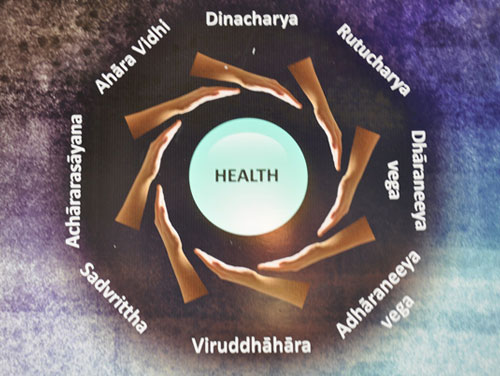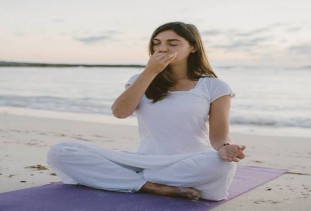
This shloka from Charak Samhita means: Ayurveda is a science
that describes the advantageous, disadvantageous, happy and unhappy
states of life, in addition to what is good and bad for life and its measurement
HISTORY / ORIGIN OF AYURVEDA / AYURVEDAVATARANAM
Lord Brahman, recalling to his mind the science of life (Ayurveda), taught it to Daksha (Prajapathi). He taught it to Ashwini Kumaras(twins), who in their turn taught it to Indra(the kings of the gods). When diseases began to trouble the human beings, the great sages of the world assembled in the slopes of the Himalaya mountains and resolved to learn the science of Ayurveda from Indra and bring it to the world for the benefit of living beings. Sage Bharadvaja , one of the participants of the assembly volunteered this difficult task of going to heaven and learning the science from Lord Indra. Baradvaja who learnt the science from Indra came back to the earth and propounded it to the assembly. Krishna Atreya also known as Punarvasu Atreya , son of sage Atri, taught this science to his six disciples namely Agnivesha , Bhela , Jatukarna , Parashara , Haritha and Ksharapani. Each one of them wrote a treatise and placed them before their teacher Krishnatreya and the assembly of sages. The treatise of Agnivesha was adjudged as the best and praised even by gods. It became popular in the world (CHARAKA SAMHITHA- SUTRA STHANA CHAPTER 1).

The teachings of Krishnatreya mainly deals with inner medicine i.e. Kayachikitsa , one among the eight branches of Ayurveda. This school was popularly known as Athreya Sampradaya or Kayachikitsa. The treatise written by Agnivesha is now available not in its original form but in its revised version known as Charaka Samhitha because it was redacted or re-edited by Charaka Muni for the first time. It underwent a second redaction from the pen of Dridabala . Modern scholars assign Krishnatreya and Agnivesha to 6th and 5th cent.B.C. , Charaka Muni to 2nd cent.A.D. and Dridabala to 4th cent.A.D

WHY AYURVEDA
Ayurveda is an ancient Indian system of medicine.It had attracted the attention of medical men not only in India but also our neighbouring countries such as Arabia, Persia, Tibet and Germany. Ayurveda is broadly classified into 8 branches. Kayachikitsa: Inner medicine or a treatment for diseases arising from digestive activity. Bala chikitsa: Paediatric care dealing with diseases affecting infant n children. Graha chikitsa : Treating the diseases arising from possession by evil spirits, pathogenic micro oraganisms etc. It deals with mental health and illness i. e psychiatry. Urdhwanga chikitsa : deals with treatment of head including eyes(opthamology),ears (otology),nose(rhinology),throat (laryngology) and teeth (dentistry).
Shayla chikitsa : treatment which requires the use of knife i. e Shastra chikitsa (surgery). Damstra chikitsa : treatment of diseases due to poison (toxicology) Jara chikitsa : also called as rasayana chikitsa which deals with treatment of diseases of old age. i. e gerientology or geriatrics.. Vrisha chikitsa : treatment for impotence, sterility etc. And making man sexually strong by the use of aphrodisiacs.
HEALING POWER OF THE HERBS
SARVAM DRAVYAM AUSHADHAM||
Ayurveda believes that all the plants in earth are medicine. Every single plant has its own unique medicinal value and healing power. This is why ayurveda suggests a person to follow a vegetarian diet.
Janaki Madhavam explain and offers a complete diet plan with home remedies including several herbs.
As ayurveda explains:
PATHYAM PRADHANAM AUSHADAM
that is maintaing a diet plan is equal to first medical care or first medicine. Janaki Madhavam follows a saying in ayurveda that is "If your diet is correct, then there is no need of medicine".


YOGA AND AYURVEDA
“YUJYATHE ANENA ITHI YOGA” The union of body and mind is called “YOGA”. Yoga is an ancient practice of maintaining equilibrium between body and mind. A spiritual power and a positive health is gained through the daily practice of yoga. AYURVEDA:- “AYUSHO VEDAM AYURVEDAM” The science of life which measures the life span of an individual and comforts the diseased ailments through natural process is called as Ayurveda. When yoga and ayurveda is combined there is a fullness of health , that is physically and mentally. Yoga is a part of ayurveda wherein diet, exercises, asanas and meditation are included. “JANAKI MADHAVAM” offers a wonderful combination of yoga and ayurveda for the wellness of a client. A yogic practice in a ayurvedic lifestyle will substantiate the complete meaning of helath. A diseased free lifestyle will be attained by practicing yoga and following ayurveda in daily life. JANAKI MADHAVAM makes sure that the client is completely satisfied in terms of understanding their disease or problem and their body responding to the disease and treatments offered internally and externally. A proper diet according to the constitution of a person will be discussed in detail to maintain the body fit and healthy. A daily regimen according to the season and climatic condition will be offered here by our experts. Complete description about the disease and treatment modalities will be shared with the patient before the treatment starts.
BLOG
Human Body
Body is the temple where God resides. So keeping body healthy makes one reach God or enjoy the worldly pleaures depending on the goal.


Pranayanama
Pranayama, a well known word amongst people doing yoga. Well if one thinks of pranayama as a exercise only for health then one is misunderstood .

